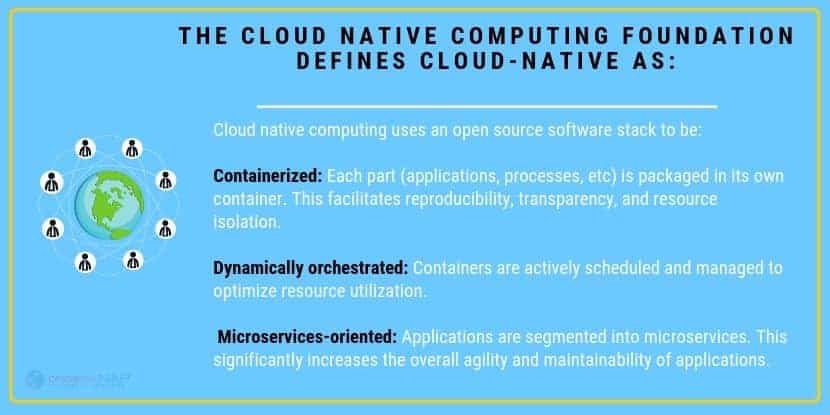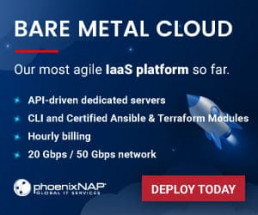Cloud native application architecture allows software and IT to work together in a faster modern environment.
Applications designed around cloud-native structure define the difference between how new technology is built, packaged, and distributed, instead of where it was created and stored. When creating these applications, you retain complete control and have the final say in the process.
Even if you are not currently hosting your application in the cloud, this article will influence how you develop modern applications moving forward. Read on to find out what cloud native is, how it works, and it’s future implications.
What is Cloud-Native? Defined
Cloud native in terms of applications are container-based environments or packaged apps of microservices. Cloud-native technologies build applications that contain several services packaged together which are deployed together and managed on cloud infrastructure using DevOps processes which provide uninterrupted delivery workflows. These microservices create what is called the architectural approach, which is in place to create smaller bundled applications.
What is a Cloud-Native Architecture?
Cloud–native architecture is built specifically to run in the cloud.
Cloud-native apps start as packaged software called containers. Containers are run through a virtual environment and become isolated from their original environments to make them independent and portable. You can run your personalized design through test systems to see where it’s located. Once you’ve tested it, you can edit to add or remove options.
Cloud-native development allows you to build and update applications quickly while improving quality and reducing risk. It’s efficient, run responsive, and scalable. These are fault-tolerant apps which be run anywhere, from public or private environments, or in hybrid clouds. You can test and build your application until it is precisely how you want it to be. For development aspects that you are not an expert in, you can easily outsource them.
The architecture of your system can be built up with the help of microservices. With the help of these services, you can set up the smaller parts of your apps individually, instead of reworking the entire app, all at once. More specifically, with DevOps and containers, applications become easier to update and release. As a collection of loosely connected services, such as microservices are easier to upgrade instead of waiting for one significant release which takes more time and effort.
Lastly, you’ll want to make sure your application has access to the elasticity of the cloud. With this elasticity it allows your developers to push code to production much faster than in traditional server-based models. You can move and scale your app’s resources at any time.
What Are The Characteristics of Cloud Native Applications?
Now that you know the basics about cloud-native apps, here are a few design princicples that you discuss with your developer in the development stages:
Develop With The Best Languages And Frameworks
All services of cloud-native applications are made using the best languages and frameworks. Make sure you can choose what language and framework suites your apps best.
Build With APIs For Collaboration & Interaction
Find out if you’ll be using fine-grained API-driven services for interaction and collaborating your apps, which are based on different protocols for different parts of the app. For example, Google’s open-source remote procedure call, or gRPC, is used for communication inside different services.
Agile DevOps & Automation
Confirm the capability of your app of becoming fully automated, to manage large applications.
How is your application being defined via protocols? Such protocols are CPU and storage quotas and network policies. The difference between you and an IT department when it comes to these protocols is that you are the owner and have access to everything, the department doesn’t.
Managing your app through DevOps will give your app its own independent life. See how different pipelines may work together to send out and manage your application.
Building Cloud-Native Applications
Application development will differ from developer to developer, depending on their skills and capabilities. Common to most cloud-native apps are the following characteristics, which are added in during the development process.
- Updates – Your app will always be available and up to date.
- Multitenancy – The app will work in a virtual space, sharing resources with other applications.
- Downtime – If a cloud provider has an outage, another data center can pick up where it left off.
- Automation – Speed, and agility rely on audited, reliable, and proven processes that are repeated, as needed.
- Languages – Cloud-native apps can be written in HTML, Java, .Net, PHP, Ruby, CSS, JavaScript, Node.js, Python, and Go, never in C/C++, C#, or any virtual studio language.
- Statelessness – With cloud-native apps being loosely coupled, apps aren’t tied to anything. The app stores itself in a database or another external entity, but you can still find them easily.
- Designed modularly – Microservices run the functions of your app, they can be shut off when not needed, or be updated in one section, rather than the entire app being shut down.
The Future of Cloud-Native Technologies
Cloud-native has already proven with its efficiencies that it is the future of developing software. By 2025, 80% of enterprise apps will become cloud-based or be in the process of transferring themselves over to cloud-native apps. IT departments are already switching to developing cloud-native apps to save money and keep their designs secure off-site, safe from competitors.
Adoption now will save yourself the hassle of doing it later, when it’s more expensive.
By switching over to cloud-native apps, you’ll be able to see first-hand what they have to offer and benefit from running them yourself for years to come. Now, that you know how to take advantage of new types of infrastructure, you can continue to improve it by giving your app developers the tools they need. Go cloud-native and get the benefits of flexible, scalable, reusable apps that use the best container and cloud technology available.
What to Look for When Outsourcing Cloud Native Apps
During the planning process, many companies decide to hire a freelancer to help out in developing and executing a cloud-native strategy. It pays off to have a developer experienced in increasing the speed of applications development and organizing compute resources across different environments. It can save you time, money, and a lot of frustration.
When looking for an application developer remember to take these things into consideration,
- Trust – Ensure that they will keep your information safe and secure
- Quality – Have they produced and provided high quality services to other businesses?
- Price – In creating your own apps, you don’t want to overspend Compare process and services to keep prices down
Cloud-native development helps your company derive more value from hybrid cloud architecture. It’s so important to partnerwith a company or contractor that has experience and a great track record.
Go cloud-native and partner with PhoenixNAP Global IT Services. Contact us today for more information.

